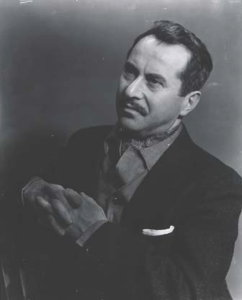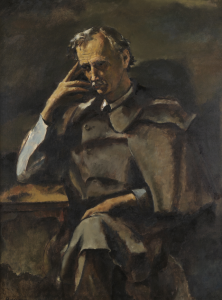
(Peter A. Juley & Son, 1960s)
Biography
Raymond Breinin was born in 1910 in Vitebsk, Russia. At age 7 he took art lessons from Uri Penn, who had also instructed Marc Chagall. Later he studied at the Vitebsk Academy of Art, which Chagall had founded and was then directed by Kazimir Malevitch. In 1922 his family fled the Soviet Union and emigrated to New Rochelle, IL, moving to Chicago a year later.
Breinin attended public school until economic necessity forced him to look for work. He held various jobs - in commercial lithography, painting theater posters, and running an elevator in a hotel. Meanwhile he pursued his own art education at Chicago's Art Institute.
He found employment with the Public Works of Art Project and completed an ambitious mural for the Skokie School in Winnetka, IL entitled "Give us the Unity of Men and We Shall Build a New World." Unfortunately, while Breinin adhered to PWAP guidelines about projecting an optimistic view of society celebrating unity and industry, his work was immediately condemned by the Winnetka Board of Education and walled over. Fragments of the mural were recovered in 2003.
Breinin continued to work in a variety of media. He produced murals for the Ambassador East and Drake Hotels in Chicago and designed the interiors of two Chicago restaurants. His work was discovered by Edith Halpert, owner of the Downtown Gallery in New York, where he had a one-man exhibit in 1939. Halpert was an ongoing sponsor of Breinin's, holding shows for him for nearly two decades.
Breinin won the purchase prize at the Metropolitan Museum of Art's "Artists for Victory" exhibition (1942) and received commissions for work in Life, Fortune and Redbook magazine. He designed sets and costumes for the American Ballet Theater. He was artist in residence at the University of Minnesota and later at Southern Illinois University. Breinin taught at the Art Students League in the 1960s and at the National Academy of Design in the 1970s. He continued to work on set design and was in fact working on such a project at the time of his death in 2000.


Critical Analysis
Breinin is best known for his imaginary landscapes, which introduce religious or medieval figures floating over an urban environment. Such paintings led Time Magazine to dub him the "Windy City Mystic." Other works involved simpler landscapes, still lifes and portraits. But even these may have some other-worldly aspects. "The Dead Tree," for example shows a tree in the foreground with a battered house behind it. But, seemingly floating away in the distance, there is another house, slowly getting lost into the horizon. The overall effect is a very evocative portrait of a Dust Bowl scene.
One of Breinin's mystical works, "The Engulfed Cathedral," was inspired by a Debussy tone poem and commissioned by a phonograph manufacturer. Perhaps they saw a resurrection motif in the image of a cathedral rising out of the ocean and hoped that a war-weary public would find relief in this thought. It does, however, seem like an odd direction for an advertiser to take - unless it was just a sign of Breinin's popularity in the moment.
Murals
- Wilmette, Illinois - Post Office: In the Soil Is Our Wealth
References
- Harry Salpeter, Church Spires and Flying Steeds, Esquire February 1 (1945).
- The Dead Tree (Illinois State Museum).
- The Engulfed Cathedral (NY Showplace).
- Taylor, The Great Depression, taylor541 March 28 (2016).
- Raymond Breinin (Raymond Breinin).
- Raymond Breinin (Art Institute of Chicago).
- Sally Schneiders, When Art was Threatening: The Hidden WPA Mural at Skokie School, Winnetka Historical Society Gazette Fall/Winter (2014).
- Windy City Mystic, Time August 10 (1942).
- Chicago Tribune, Winnetka Gives Mural 2nd Chance, Chicago Tribune December 30 (2003).